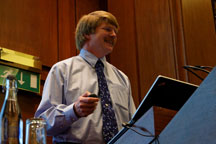Team Biographies

Mike Ressler
project scientist for the mid-infrared instrument (MIRI)
Mike Ressler is the NASA Project Scientist for the Mid-InfraRed Instrument (MIRI) on NASA's James Webb Space Telescope. He is based at NASA's Jet Propulsion Laboratory (JPL) in Pasadena, Calif. His primary job is to ensure that the observations desired by the astronomical community can be carried out by MIRI, especially with regard to the detector and cooler subsystems that are JPL's responsibility.
In 1986, Ressler received his bachelor's degree in Physics from the Massachusetts Institute of Technology, Cambridge, followed by a Ph.D. in Astronomy from the University of Hawaii at Manoa in 1992. He came to JPL after graduation as a National Research Council Postdoctoral Fellow, and joined the JPL staff in 1994. He currently holds the rank of principal scientist.
Since he was an undergraduate, Ressler has been involved in building infrared astronomical instruments, and specializes in their design and in the operation of the detectors. He has worked on ground-based instruments used on the Keck Telescopes and the 3-meter NASA Infrared Telescope Facility, both atop Mauna Kea in Hawaii, and the Palomar 200-inch telescope near San Diego, Calif.
He is also a detector specialist and a member of the science team for NASA's Wide-field Infrared Survey Explorer (WISE) all-sky survey. His duties included evaluating the impact of the South Atlantic Anomoly (a region near South America where radiation levels above the atmosphere are especially high) on the WISE detectors and the corresponding survey strategy, and evaluating the overall reliability of the 563 million sources in the All-Sky Source Catalog. He also had the distinction of having the first scientific paper published using results from that mission.
Ressler's scientific interests focus on the early stages of star formation, but he has also been involved in a broad range of topics from asteroid studies to infrared-bright galaxies.
Ressler lives in Southern California with his wife, three children, and a variety of four-footed friends. He enjoys camping out in the desert, where he can actually see the skies he studies electronically.




